1. Design for
Uncomfortable Consumption
 Food-safe cricket composite bowl overflowing with roasted crickets
Food-safe cricket composite bowl overflowing with roasted crickets2021 - 2022
Individual Thesis Project
Material-Driven Design; Mechanical Design; Interventionist Art; Experience Design https://issuu.com/adamhuth/docs/adam_huth_thesis_w_cover?fr=xKAE9_zU1NQ
Design for Uncomfortable Consumption is a materials-driven design exploration of crickets as a food and material. Public interventionist art is used to facilitate uncomfortable conversations around Western consumption, sustainability, food systems, ethics, culture, and race. For thousands of years, humans have eaten insects - however, the United States, and much of the West, has yet to integrate insects into a regular diet. Insects are an emerging technology capable of producing new materials, medicines, and ways of life. In the project, insects are utilized as a material - cricket based bioplastics and composites are crafted and used to serve food at a mobile kitchen called “Bug Bike Bistro”. The bistro acts as a stage for public interventionist art performances and as a space of public engagement and documentation, and is designed to be adaptable to a range of settings and situations, allowing the project to continuously evolve as more knowledge is shared between the performer and strangers. The intervention aims to use discomfort, collaboration, speculation, and leisure to shift perspectives of a westernized public, making people consider more carefully their food sources and general consumption, their relationship to their own and others’ cultures, and their stances and knowledge on ethics both in and out of food.
 The initial project starting point: cricket powder based bacon with cornstarch and seasoning; the project quickly shifted past a capitalist meat production model
The initial project starting point: cricket powder based bacon with cornstarch and seasoning; the project quickly shifted past a capitalist meat production model A material sample of a cricket composite, made from cricket powder and food safe epoxy; multiple iterations with different ratios were made; these cricket composites are durable and food safe
A material sample of a cricket composite, made from cricket powder and food safe epoxy; multiple iterations with different ratios were made; these cricket composites are durable and food safe A bioplastic sample made from cricket powder, gelatin, glycerol, and water; while compostable (and technically edible), these cricket bioplastics do not hold up well to moisture or heat
A bioplastic sample made from cricket powder, gelatin, glycerol, and water; while compostable (and technically edible), these cricket bioplastics do not hold up well to moisture or heat Stir fried fresh crickets cooked in toban djan served alongside white rice, seared mushrooms, and broccoli; the main course as part of a private test installation and ideation session
Stir fried fresh crickets cooked in toban djan served alongside white rice, seared mushrooms, and broccoli; the main course as part of a private test installation and ideation session Brainstorming sticky notes from Abhijeet Ghavalkar and Effie Jia, responding to the prompt “how to engage with the public and create project documentation?”
Brainstorming sticky notes from Abhijeet Ghavalkar and Effie Jia, responding to the prompt “how to engage with the public and create project documentation?” Used Burley bike trailer for children purchased on Marketplace; the test performance highlighted that more space was needed for a mobile kitchen than planned
Used Burley bike trailer for children purchased on Marketplace; the test performance highlighted that more space was needed for a mobile kitchen than planned Form finding with the stripped down bike trailer mechanisms; the frame’s ability to fold flat created an opportunity for a pop-up counter top space for cooking and dining
Form finding with the stripped down bike trailer mechanisms; the frame’s ability to fold flat created an opportunity for a pop-up counter top space for cooking and dining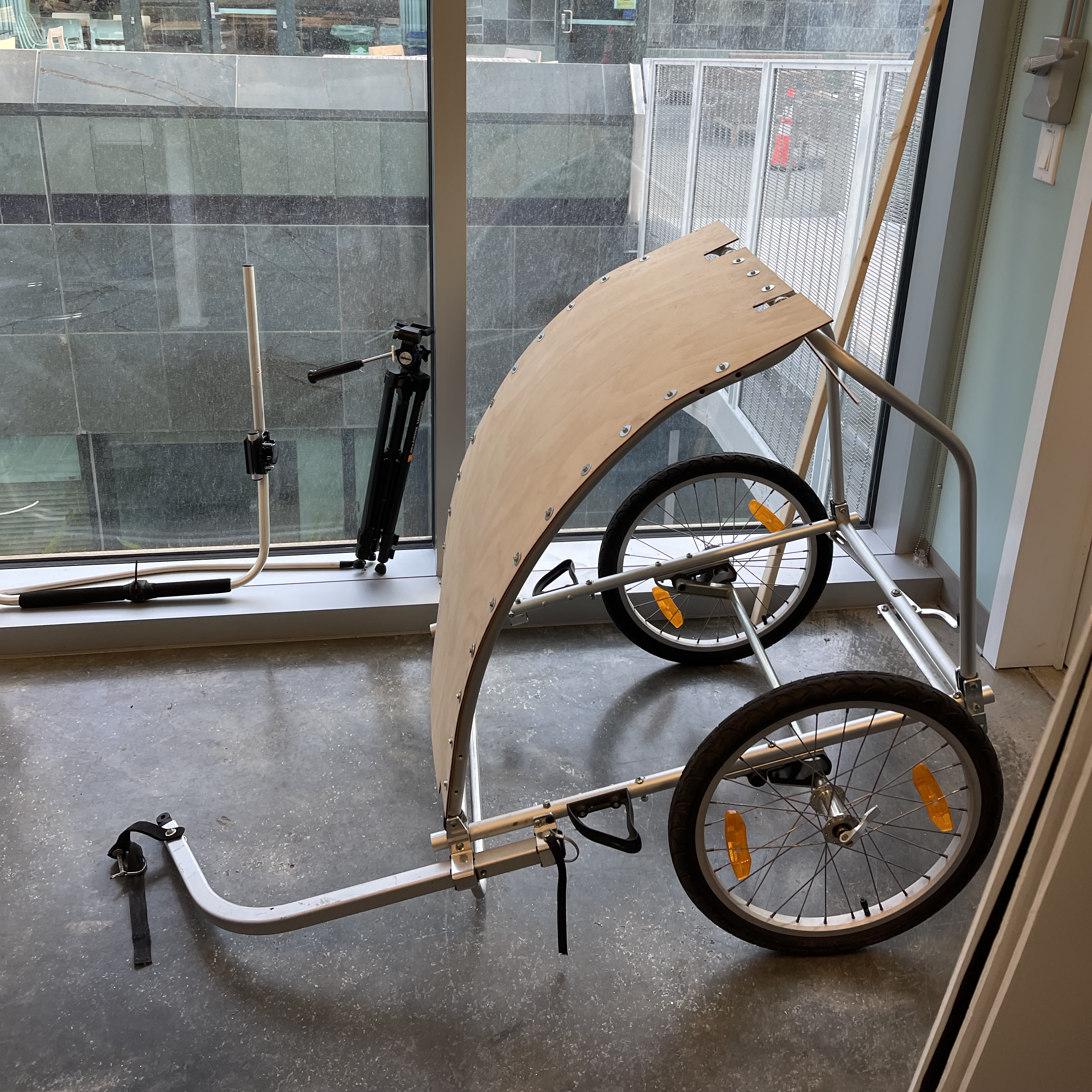 The first piece of plywood added to the frame; plywood was soaked and steamed in order to bend to the curves of the aluminum tubing
The first piece of plywood added to the frame; plywood was soaked and steamed in order to bend to the curves of the aluminum tubing The finished trailer with table top mounted to the side after first test ride; fairly easy to maneuver and tow with a bicycle, allowing access to nearly any public space
The finished trailer with table top mounted to the side after first test ride; fairly easy to maneuver and tow with a bicycle, allowing access to nearly any public space The trailer loaded with materials for the first public intervention; one and two burner stoves, 2.5 gallons of water, ingredients, ice chest, cooking equipment, and more
The trailer loaded with materials for the first public intervention; one and two burner stoves, 2.5 gallons of water, ingredients, ice chest, cooking equipment, and more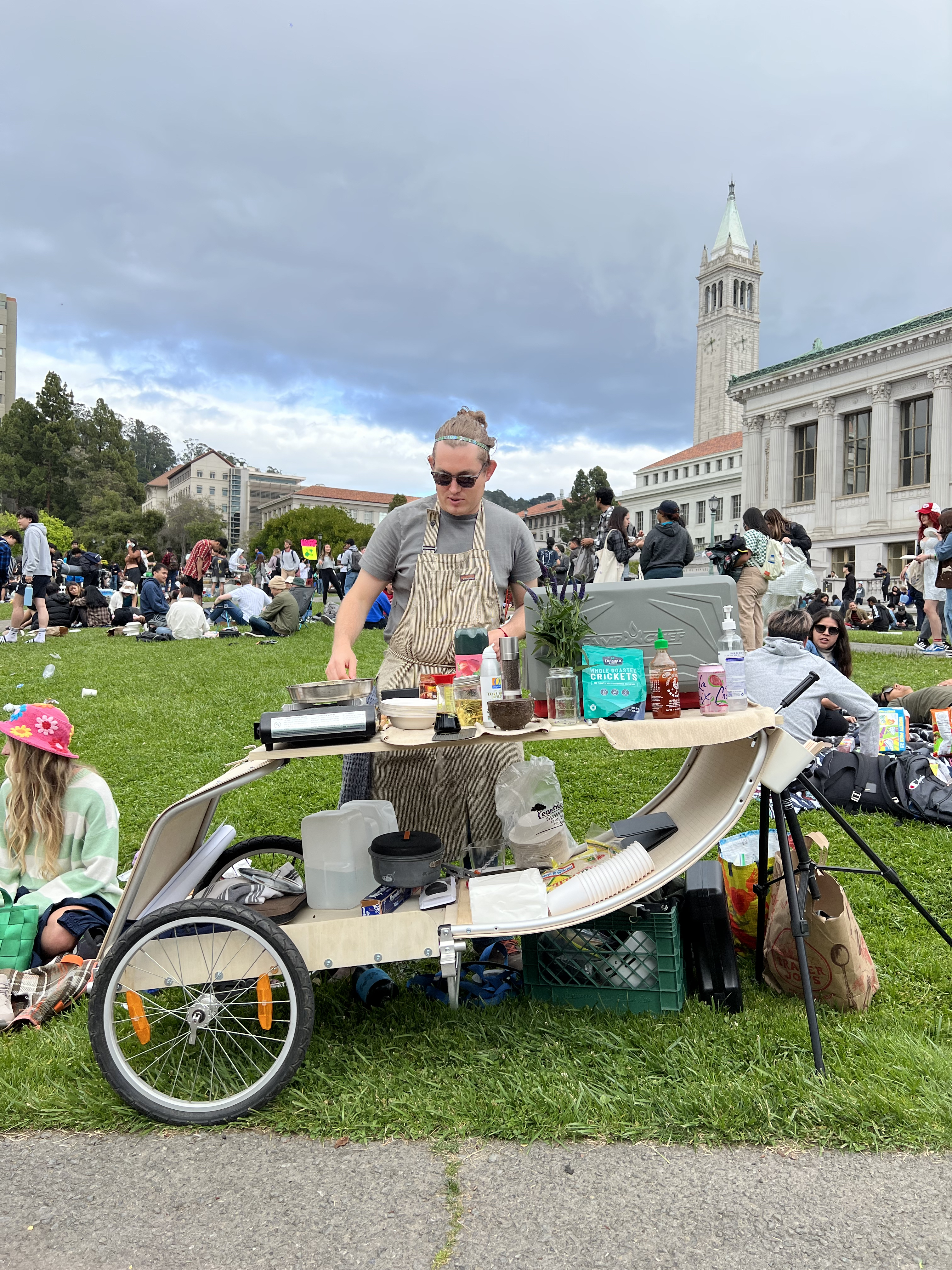 Bug Bike Bistro deployed for the first public art intervention; crickets were cooked in toban djan and served with rice and vegetables; approximately 50 free meals served
Bug Bike Bistro deployed for the first public art intervention; crickets were cooked in toban djan and served with rice and vegetables; approximately 50 free meals served Preparing fresh guacamol in a molcajete as a topping on mini chapulines (seasoned grasshoppers) tacos; Day 1 of 2 of exhibition at Platform Artspace
Preparing fresh guacamol in a molcajete as a topping on mini chapulines (seasoned grasshoppers) tacos; Day 1 of 2 of exhibition at Platform Artspace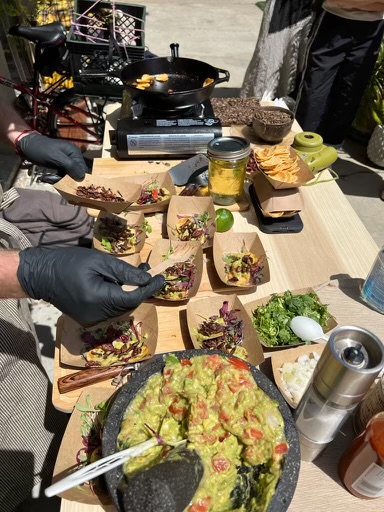 Plating chapulines tacos with fresh guacamole and microgreens; tortillas were cut with a cookie cutter to yield 3 mini tortillas
Plating chapulines tacos with fresh guacamole and microgreens; tortillas were cut with a cookie cutter to yield 3 mini tortillas Two students watching the assembly of tacos while learning about the benefits of eating insects
Two students watching the assembly of tacos while learning about the benefits of eating insects Serving tacos to a UC Berkeley class on the intersection of the arts and sustainable food systems; Day 2 of 2 of exhibition at Platform
Serving tacos to a UC Berkeley class on the intersection of the arts and sustainable food systems; Day 2 of 2 of exhibition at PlatformThis project provides new frameworks for designers to introduce new technologies and ideologies to the general public in a way that is collaborative and unexpected. With regards to the food being prepared, the public is informed of an alternative protein source, how they can prepare it, and how they can produce it themselves. Utilizing interventionist art, materials-driven design, and methods of engagement such as discomfort and defamiliarization, Design for Uncomfortable Consumption successfully introduced a uncommon ingredient to Western palettes and activated discourse around topics like consumption, food sources, and culture.
As the project develops into the future, Bug Bike Bistro will be taken to multiple places within the United States and “the West” in order to provoke action around consumption; more people will be fed with a wider range of ingredients and insects. Further material research will allow for more durable, sustainably extracted chitin-based materials that could be scaled and used not only in interventions but also in commercial applications.
 Using a food safe two part putty to make a mold of a small glass
Using a food safe two part putty to make a mold of a small glass A mold of a bowl filled with a food safe resin and crushed roasted cricket mix- ture; in the process of drying
A mold of a bowl filled with a food safe resin and crushed roasted cricket mix- ture; in the process of drying Washing fresh crickets to be served in a dish at the final presentation and demo
Washing fresh crickets to be served in a dish at the final presentation and demo A material tile made from dry roasted crickets and resin for display at the final showcase exhibition
A material tile made from dry roasted crickets and resin for display at the final showcase exhibition A full dinnerware set made for the final showcase exhibition; plates, bowl, silverware, and cups made from cricket composite; place mat made from cricket bioplastic
A full dinnerware set made for the final showcase exhibition; plates, bowl, silverware, and cups made from cricket composite; place mat made from cricket bioplastic Ingredients organized on the Bug Bike Bistro before a live cooking demo during the final presentation
Ingredients organized on the Bug Bike Bistro before a live cooking demo during the final presentation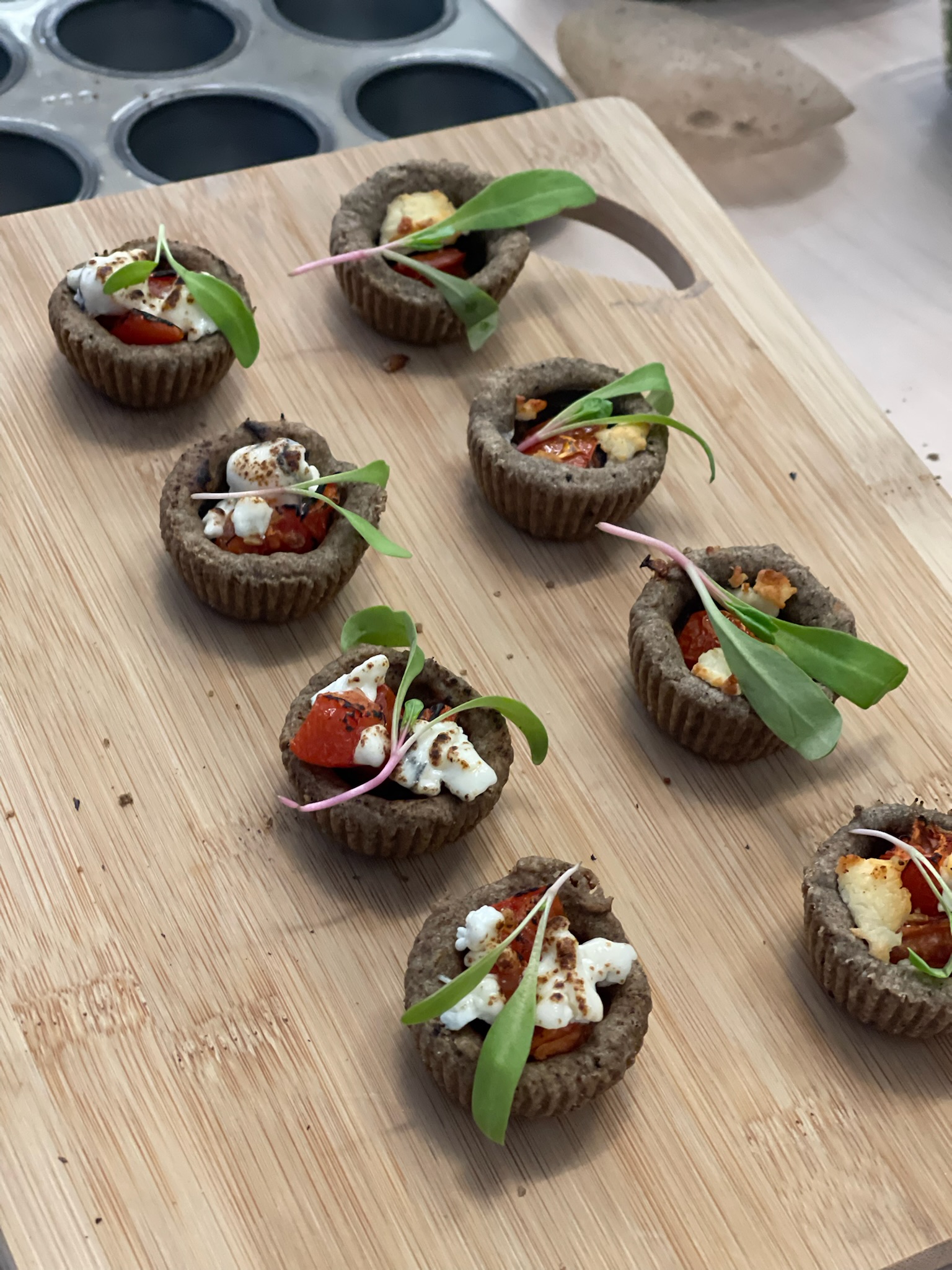 Jardin d’Eden; a cricket-based shortbread tart with roasted to- matoes and Humboldt Fog goat’s cheese; the first of three dishes; served on bioplastic plates
Jardin d’Eden; a cricket-based shortbread tart with roasted to- matoes and Humboldt Fog goat’s cheese; the first of three dishes; served on bioplastic plates A Bit of This, A Bite of That; stir fried fresh crickets tossed in toban djan, sesame oil, and aromatics, served on a bed of white rice and microgreens; plated on cricket composite plate
A Bit of This, A Bite of That; stir fried fresh crickets tossed in toban djan, sesame oil, and aromatics, served on a bed of white rice and microgreens; plated on cricket composite plate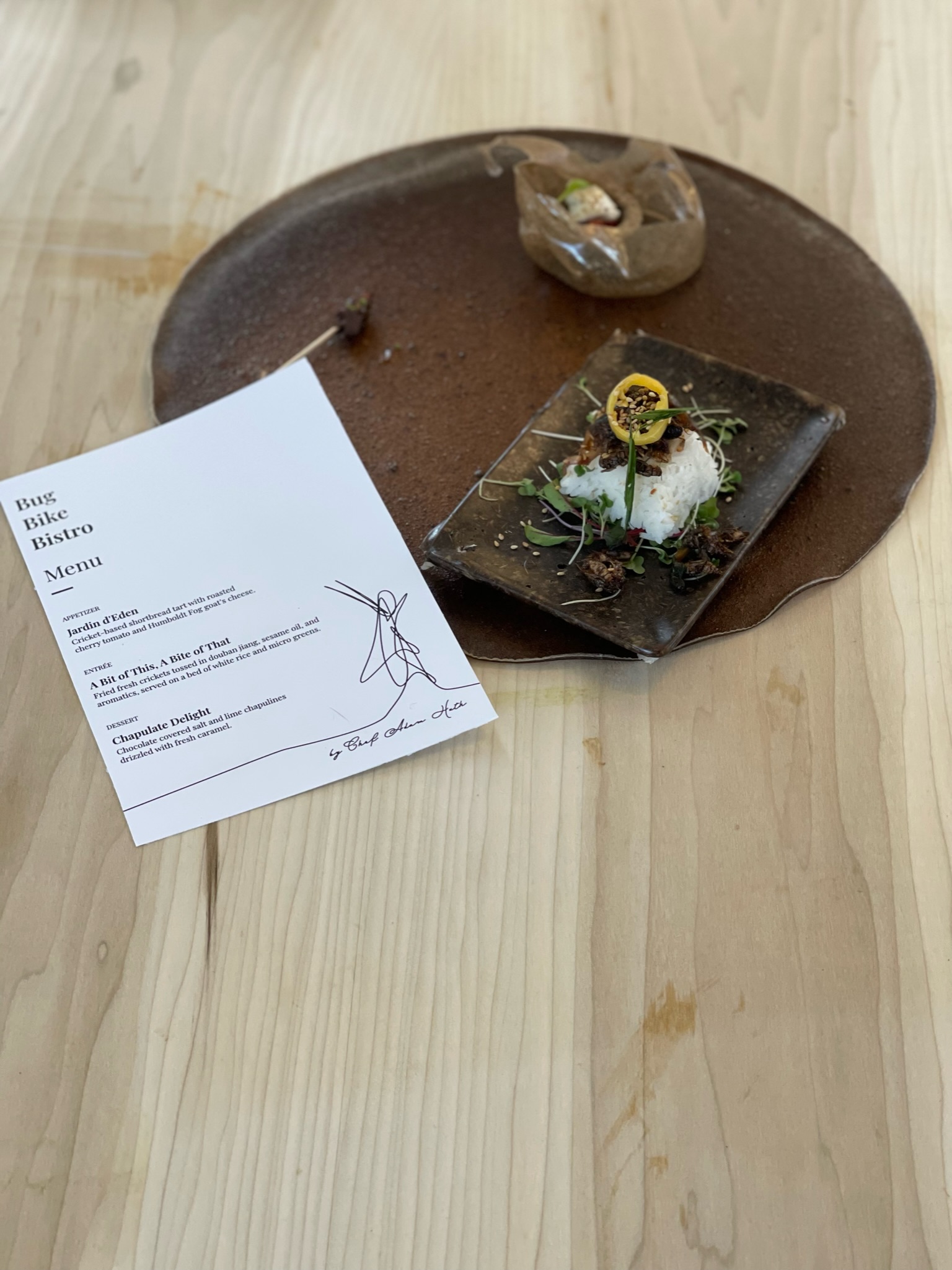 All three dishes that were served to the audience, on top of a bio- plastic placemat
All three dishes that were served to the audience, on top of a bio- plastic placemat